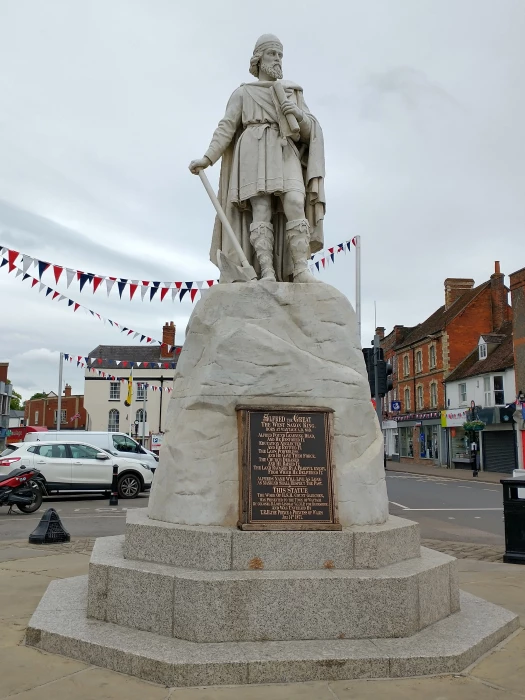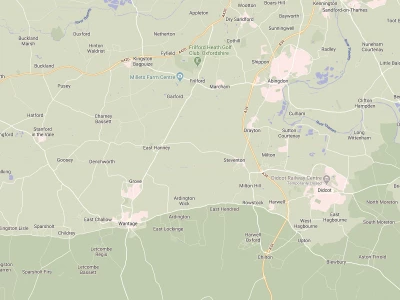Wantage Town Centre
Wantage Town Centre
By Trevor Hancock, read by Andrea Yates
The track can be heard here: Wantage Town Centre
More information about Trevor Hancock's history of Wantage can be found here: Penny Post
More information about Andrea Yates, Town Centre Manager of Wantage, can be found here: Andrea Yates
More information about the Bear can be found here: British Listed Buildings
The text is as follows:
Hello. My name is Andrea Yates and I'm the Town Centre Manager working for Wantage Town Council. I'm going to tell you about some iconic structures, which are all still standing today around the marketplace.
We're going to start with the King Alfred statue. The King Alfred statue was unveiled on 14th July 1877 by the Prince of Wales. The statue is sculpted from Sicilian marble and stands on a base of Cornish granite. It was commissioned by Colonel Robert Loyd-Lindsay VC, later Lord Wantage, at the cost of 2000 pounds. The statue commemorates the birth of King Alfred the Great 849 AD.
The sculptor, Count Gleichen, was Queen Victoria's nephew and he was born in 1833. His mother was the half sister of Queen Victoria. With the Queen's help, he came to England and, after naturalization, he joined the Royal Navy as midshipman. Unfortunately, ill health forced him to retire from the Navy, and after three years tuition with William, Theed, a prominent sculptor of the time, he set up his own studio in the grounds of St. James' Palace, obviously with the permission of Queen Victoria. It was there that a sculpture was completed and then transported to be erected here in Wantage.
If you look towards the other end of the town centre, behind the King Alfred statue, you will see the Post Office vaults building. In 1774, William Wise, who was a clock maker and postmaster, purchased the Fleur de Lis public house, and remained postmaster there until his death in 1823. By 1842, Joseph Lewis was running the Post Office in the Post Office vaults before it moved to Newbury Street. Previously, it had been a bank owned by William Mattingly, who was a draper and banker.
The accountants, Jay Jenkins and Associates, which are there now, was originally a wine and spirits merchants run by Edward Davey, a noted antiquariun, historian and businessman in Wantage during the 19th Century. Today, the Post Office vaults has various businesses within, including Lily boutique, the Vaults Pizzeria and Bar, and Simpsons estate agents.
Moving onto the old town hall. Where you see King Alfred's statue, this was originally, before 1877, the site of the original town hall, but it was never popular due to the fact that the architect was the same one that built, Wantage workhouse in Manor Road. Therefore, a new town hall was needed and the building on the corner of marketplace and Grove Street was built.
The site was originally the Falcon Inn and was purchased by Colonel Loyd-Lindsay for 900 pounds. The cost of erecting the new town hall and the building next door was met by subscription. Colonel Loyd-Lindsay, and his father-in-law Lord Overstone, gave 1,400 pounds. The Tanner neighborhood 925 pounds. The county contributed 700 pounds to hold the court in the building and the sale of materials from the old town hall raised 265 pounds. The architect was a Mr. Tasker of London and Colonel Loyd-Lindsay's agent, Mr. Dolby, supervised the building. The bricks were made near Bede in Newbury, and the timber prepared at Ardington.
The building on the right, a shoe warehouse and the former Globe Inn was also purchased by Colonel Loyd-Lindsay and became Mrs. Samson's shoe warehouse, a registered office for servants and a coffee tavern formed in 1880. The town hall was sold by Wantage Urban District Council in 1954, and became the Midland or HSBC bank as it was known. It has recently been refurbished and is now the home to the Helping Hands Care Agency.
On the opposite side of the marketplace to the Helping Hands Agency, which was formerly the town hall, you will see the Victoria Cross Gallery. At the beginning of the 19th Century, this building was the Red Lion Inn, but it was sold to the Corn Exchange Company and the courtyard at the rear was roofed over in 1865.
Subsequently, the Wantage Town Commissioners bought the Corn Exchange building in 1893, and it was then renamed the Victoria Cross Gallery in November 1900 on the day Lord Wantage gave 46 paintings, mostly of the first recipients of the Victoria Cross by the artist, Louis William Desanges. The paintings had been exhibited at Crystal Palace, and Lord Wantage bought the collection fearing it would be dispersed. They were presented to the town of Wantage and placed in the care of the Wantage Urban District Council.
After WWII, during which the paintings were kept in storage, which was not that adequate, the paintings were, apart from the one of Lord Wantage himself, dispersed to various regimental and national museums such as the National Army Museum. The Beacon, which was formerly the Wantage Civic Hall has the painting of Lord Wantage today and a couple of the other originals plus prints of others, which you can see if you walk up the stairs.
Next to the Victoria Cross Gallery is the Bear Hotel. The Bear is actually older than its facade suggests. Tradesmen's tokens were issued by Thomas Herdman in the 17th Century. Each one embossed with a bear and chain. The earliest mention of the Bear in Wantage is in 1567, when 10 pence was paid to John Payne of the Bear for a load stone. The hotel had stables for 60 horses, which used to be where the Renaissance homes are today, and before that, the former police station.
As you can imagine, there are lots of stories about the Bear and especially about the bear that used to stand outside on a pedestal. The North Wilts Herald in 1873 reported on the demolition of the carved black bear on top of the pedestal outside the Bear Hotel. At this time, the Berkshire Yeomanry used to be billeted in the town whilst they were on manoeuvres taking place on the Berkshire Downs. A group of soldiers decided to whitewash the bear on its pedestal. However, when a ladder was put up against the pedestal, the pedestal, the bear, soldiers and paint all collapsed onto the cobbles below.
Repairs were attempted by the luckless soldiers, but by this time, the police had appeared on the scene. All the miscreants had to subscribe to buy a new bear, and it was placed where the old one used to be. However, now, today, the bear has a traditional inn sign outside the front of the hotel and not the model of a bear on a pedestal.
I hope you've enjoyed listening about the buildings in Wantage.


